The most prolific cover artist from The Saturday Evening Post, J.C. Leyendecker, influenced the way we look at Santa during Christmas, turkeys and pies at Thanksgiving, and fireworks on the Fourth of July.
“Fourth of July, 1911”
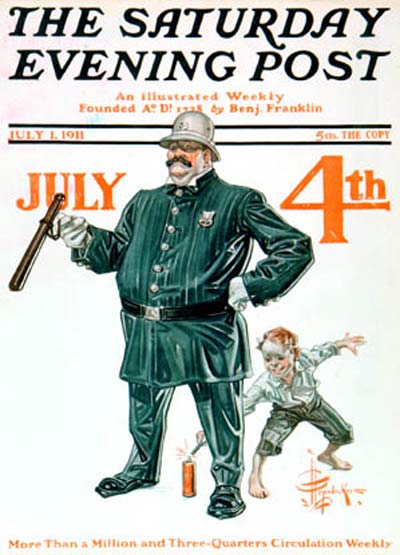
“Fourth of July, 1911”
from July 1, 1911
A style that went from comic to elegantly lavish to sentimental made J.C. Leyendecker the most versatile of all the Post artists. His March 1909 cover gives us a delightful rendition of newly inaugurated William Howard Taft (See Post Presidential Covers) and an April 1912 cover shows a sumptuously attired couple on their Easter walk. From there he ventures into humor as in this cover of an urchin courting trouble.
Leyendecker was hired by legendary publisher, George Horace Lorimer, who purchased the Post in 1897, when it had a circulation of a few thousand. Less than 15 years later, this cover boasts of a circulation of “more than a million and three-quarters weekly.”
“July Fourth at the Beach”
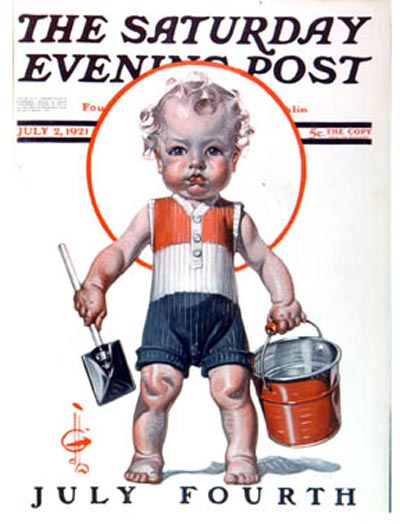
“July Fourth at the Beach”
from July 2, 1921
Leyendecker illustrated more than 300 Post covers from 1899-1943 and became the go-to artist for the holidays. His New Year’s baby was legendary and it is a testament to the illustrator’s longevity that he did 36 of these. He also did more Christmas covers (although Rockwell was close behind) and far more Thanksgiving and Fourth of July covers (27 each) than any other Post artist.
The Leyendecker baby mostly, but not exclusively, represented the fresh, young New Year. The tot showed up occasionally at Easter, and as we see here, dressed in red, white, and blue for a 4th of July beach holiday.
“Fourth of July Parade”
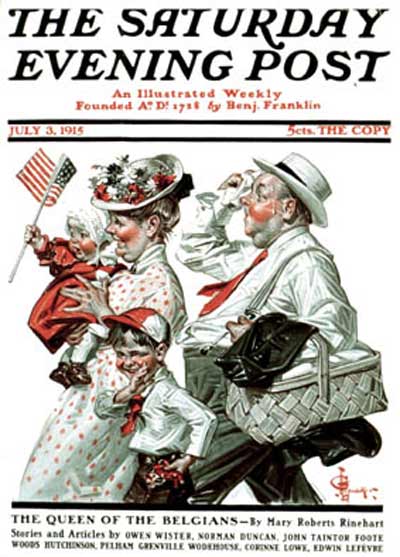
“Fourth of July Picnic”
from July 3, 1915
Joseph Christian Leyendecker was born in a tiny village on the Rhine in 1874. His brother, Frank X. Leyendecker came along three years later. Frank, who also became an artist, did 15 Saturday Evening Post covers.
The family immigrated to Chicago in 1882. Joe was able to devote himself to art full time at age 16, although the family, which was lower middle class, could barely afford the luxury of art instruction for their sons.
The hottest day of the year is not deterring this corpulent couple from attending the local parade in this 1915 cover. By the way, mom and pop might want to keep an eye on Junior — those are firecrackers he’s hiding.
“Washington and WWI Soldiers”
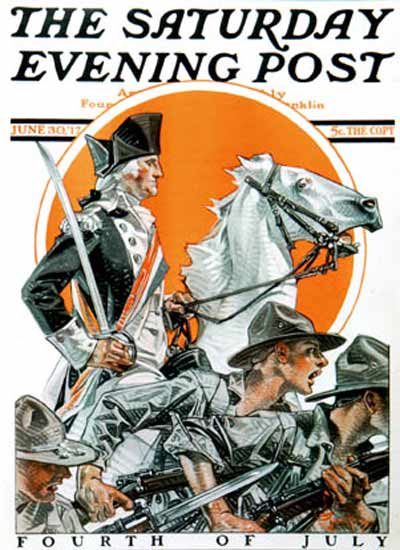
“Washington and WWI Soldiers”
from June 30,1917
Wartime brings out the patriotism, and Leyendecker invoked the spirit of George Washington to march along with the soldiers of World War I. This 1917 cover was the first of five times the artist painted Washington on the cover.
The following issue of the Post showed another side of the artist’s talent and patriotism: a recruitment ad for the United States Navy:
“Why Not Now?”
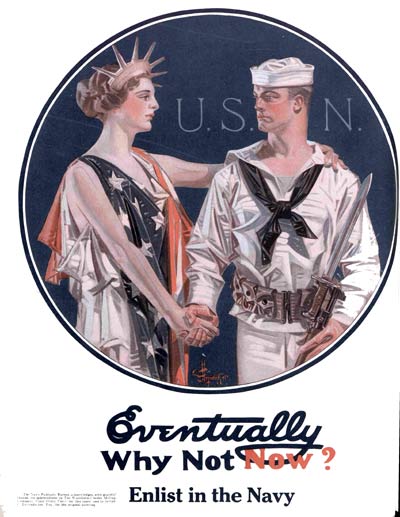
from July 7, 1917
“Fourth of July, 1913”
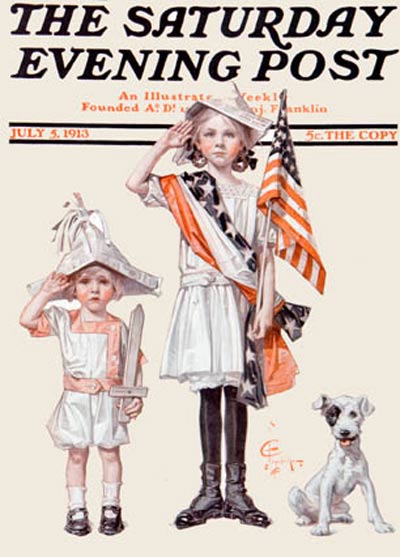
“Fourth of July, 1913”
from July 5, 1913
Newspaper hats in the early 20th century seemed to show up for festive occasions: a Christmas 1903 cover shows children wearing newspaper hats while playing with their new toys; a 1919 Rockwell cover shows a child wearing just such a hat to welcome a homecoming soldier; and these children are decked out in stars, stripes, and newsprint to salute the 4th on this cover from 1913.
“Minute Man”
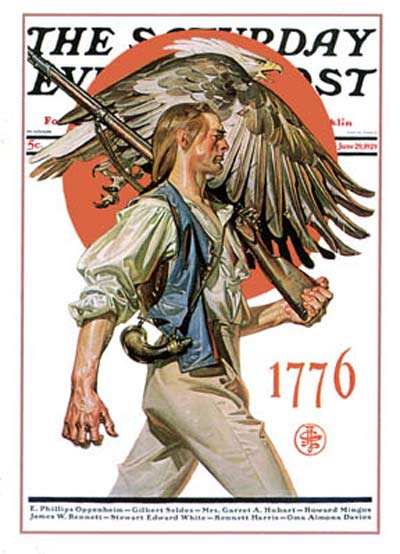
“Minute Man”
from June 29, 1929
In this 1929 cover it is the image of a rugged, can-do Minute Man that symbolized independence for the 4th. Both Leyendecker and his friend and admirer, Norman Rockwell, relished period costumes and loved painting them. This is also the image most associated with Leyendecker: the handsome, dignified, chisel-featured man who was personified in his ads for Arrow Collars. Beginning in 1905 and continuing for 25 years, the “Arrow Collar Man” was the ideal American male.
“Arrow Collar ad”

from 1914
A 1914 ad for Arrow Collars. Leyendecker was as well known for the Arrow Collar man as for his hundreds of magazine covers.
Questions about Post artists or covers can be addressed to [email protected]. Reprints of covers are available at Art.com.
Become a Saturday Evening Post member and enjoy unlimited access. Subscribe now
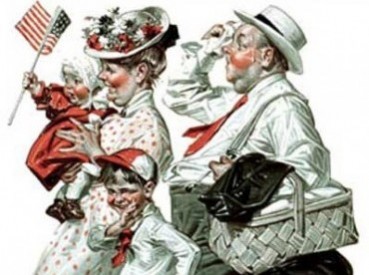
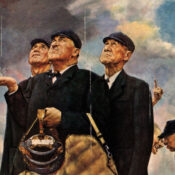

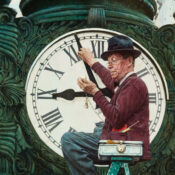
Comments
1.) ‘4th of July, 1911’ What a cover! George Lorimer really knew what he doing when he hired J.C. Leyendecker. I doubt he had ANY idea of just how successful the Post would become less than 15 years later.
2.) ‘July 4th at the Beach’. Great Leyendecker baby, excuse me, toddler, looking determined to build something at that sea shore.
3.) ‘July 4th Parade’. Terrific cover. I like the fact the kid’s letting US in on his little secret there. Mom and Dad don’t need any more stress, do they?
4.) ‘Washington and WWI Soldiers’. This is just a masterpiece. Leyendecker’s fusion of the Revolutionary War with World War I is brilliant.
5.) ‘July 4, 1913.’ I’d never read of the ‘newspaper hat’ fad of the early 1900’s before. This cover almost unwittingly foreshadowed the forthcoming World War I in an eerie way. It’s great and I love the dog of course.
6.) ‘Minute Man’. Between this guy and that angry American Eagle, the British just didn’t stand a chance, despite their military advantages otherwise.